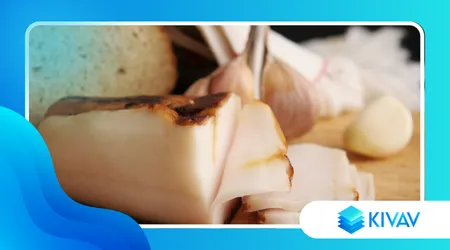Colonnata Lard: A Poor Product Turned Gourmet
The Colonnata Lard, once a humble staple on peasant tables, has transformed into a gourmet delicacy, capable of conquering the most refined palates.
Announcements
This cured meat, originally from the small village of Colonnata, in Tuscany, represents an extraordinary example of how a simple product can become a symbol of gastronomic excellence.
But what makes Lardo di Colonnata so special?
Colonnata Lard

The answer lies in its history, its artisanal tradition, and the unique flavors that derive from a production process that has remained unchanged for centuries.
In this article, we explore the journey of Lardo di Colonnata, from its humble origins to its rise to culinary iconhood, using an approach that combines data, creativity, and in-depth analysis.
Announcements
Through a mix of tradition, geography, and innovation, Lardo di Colonnata stands out not only for its flavor, but also for its connection to the territory.
This product, born as a preservation method for marble quarry workers, is today celebrated throughout the world.
++ Italian Cheeses: A Basic Guide
Its uniqueness lies in its empty space factors, in the quality of the Carrara marble and in its unparalleled seasoning.
However, Lardo di Colonnata is not just a food, but a story of cultural resilience and gastronomic excellence.
Let's discover together how a "poor" product has become synonymous with gastronomic luxury.
The humble origins of Lardo di Colonnata

A food born out of necessity
Lardo di Colonnata has its roots in the hard and industrious life of the marble quarrymen of the Apuan Alps.
In the past, lard was not considered a prestigious food, but rather a cheap and easily stored source of energy.
Quarry workers, forced to work long days, needed high-calorie, long-lasting foods.
The pork fat, seasoned with salt, herbs and spices inside the marble basins, guaranteed not only flavour but also a long shelf life.
This process, born out of necessity, gave birth to a product that today is synonymous with refinement.
Let's imagine for a moment a peasant pantry from centuries ago: lard, hanging in a cool corner, represented a reserve of energy for the most difficult months.
Its simplicity was its strength, but no one would have imagined that that seasoned fat would become a symbol of haute cuisine.
++ How to store cheese correctly
Its transformation from subsistence food to gourmet delicacy is a perfect example of how popular culture can elevate the ordinary to the extraordinary, just as a block of rough marble transforms into a sculpture under the hands of an artist.
++ Steam cooking the Italian way
The tradition of marble basins
Lardo di Colonnata is aged in marble basins, a detail that is not only picturesque, but fundamental to its unique flavor.
The porous and cool Carrara marble creates the perfect microclimate for the maturation of the lard, allowing for an even distribution of salt and spices.
This artisanal method, handed down from generation to generation, has remained almost unchanged, despite the evolution of food technologies.
Tradition, in this case, is not an obstacle, but an added value that makes the product inimitable.
We think of marble as a silent guardian: it not only protects the lard, but shapes its character, giving it a velvety texture and a complex aroma.
The basins, often hand-carved, are a symbol of the connection between Lardo di Colonnata and its territory.
Without marble, lard would simply be seasoned fat; with marble, it becomes a work of culinary art.
Isn't it fascinating how an inert material can help create such a lively flavor?
A product linked to the territory
Lardo di Colonnata is inextricably linked to the village of Colonnata, a small village nestled in the Carrara mountains.
Here, lard production is more than a craft: it's a ritual involving entire families, custodians of ancient knowledge.
The Protected Designation of Origin (PGI), obtained in 2004, protects this tradition, guaranteeing that only lard produced in this specific area can boast the name “Colonnata”.
This territorial connection is not just a question of marketing, but a guarantee of quality and authenticity.
According to a report by the Consortium of Lardo di Colonnata, approximately 50 tons of Lardo di Colonnata PGI, a limited quantity that underlines the artisanal nature of the product.
This data highlights not only the rarity of lard, but also its exclusivity this morning.
Limited production, combined with growing global demand, has helped transform it into a niche product, appreciated by gourmets around the world.
The rise to gourmet delicacy

From peasant food to gastronomic icon
How can a food created to feed workers become a symbol of luxury?
The answer lies in its versatility and its ability to surprise palates.
Lardo di Colonnata, with its soft texture and intense flavor, has proven to be a perfect ingredient for modern cuisine.
Star chefs use it to enrich sophisticated dishes, from canapés to desserts, proving that simplicity can be synonymous with refinement.
Its rise reflects a cultural shift: a return to the valorization of authentic flavors and local traditions.
An original example of using Lardo di Colonnata is the “Crostino Toscano,” where a thin slice of lard, placed on warm toasted bread, melts slightly, creating a perfect contrast with the crunchiness of the bread and the scent of the aromatic herbs.
This simple yet elegant dish embodies the essence of lard: a humble ingredient capable of elevating a culinary experience to the next level.
Its versatility makes it an unexpected protagonist in kitchens around the world.
The role of globalization
Globalization has played a crucial role in the rise of Lardo di Colonnata.
Thanks to the growing popularity of Italian cuisine, lardo has conquered international markets, becoming a must-have in high-end restaurants from New York to Tokyo.
However, this expansion has not distorted its identity: Lardo di Colonnata remains an artisanal product, produced in limited quantities and using traditional methods.
This balance between tradition and innovation is one of the secrets of its success.
Another original example is the use of lard in a gourmet salad: very thin slices of Lardo di Colonnata are wrapped around grilled prawns, creating an appetizer that combines the intense flavor of lard with the freshness of the sea.
This dish demonstrates how lard can transform simple ingredients into a memorable experience, combining tradition and creativity.
Its ability to adapt to different culinary contexts makes it a symbol of the versatility of Italian cuisine.
The art of tasting
Tasting Lardo di Colonnata is a unique sensory experience.
Its melt-in-the-mouth texture and aroma, enriched with spices such as rosemary and black pepper, create a perfect balance between delicacy and intensity.
To best appreciate it, it is best served at room temperature, perhaps accompanied by a glass of Tuscan red wine, such as a Chianti Classico.
This pairing enhances the aromatic notes of the lard, creating a moment of pure pleasure.
Lard is like a Renaissance painting: simple in its essence, yet capable of evoking profound emotions.
Each slice tells a story of work, tradition, and passion, transforming an everyday gesture like eating into an act of celebration.
Its ability to combine taste and culture makes it a unique product in the global gastronomic panorama.
Artisanal production and quality
A process unchanged over time
The production of Lardo di Colonnata is an art that requires patience and precision.
The carefully selected pork fat is cut into even pieces and placed in marble basins, alternating with layers of sea salt, spices and aromatic herbs.
After about six months of curing, the lard is ready to be enjoyed.
This seemingly simple process requires a thorough knowledge of the raw materials and environmental conditions, such as humidity and temperature.
The quality of Lardo di Colonnata also depends on the choice of ingredients.
Spices, such as rosemary and bay leaves, must be fresh and of high quality, while sea salt must be pure.
Every detail, from selecting the pork to cleaning the basins, contributes to the final result.
This artisanal approach guarantees a product that cannot be replicated industrially.
The challenge of modernity
Despite its fame, Lardo di Colonnata has to face the challenges of modernity, such as food standardization and mass production.
However, the producers of Colonnata resist these pressures, keeping the tradition alive.
The PGI certification protects not only the product, but also the production process, ensuring that each slice of lard is the result of artisanal work.
This commitment to quality is what makes lard a symbol of excellence.
Another crucial aspect is sustainability.
Limited production and the use of local raw materials reduce the environmental impact, making Lardo di Colonnata a model of responsible production.
In an age where speed often trumps quality, lard represents a cultural resistance, a return to the values of slowness and care.
The value of tradition
The tradition of Lardo di Colonnata is not just a question of technique, but of identity.
Every marble basin, every spice used, every month of aging tells the story of a land and a people.
This link with the past makes lard not just a food, but a cultural heritage.
Eating a slice of Lardo di Colonnata means savouring centuries of history.
Its global popularity has not diminished its artisanal character.
Rather, it has reinforced the importance of preserving local traditions in an increasingly globalized world.
Lardo di Colonnata demonstrates that quality and authenticity can overcome the challenges of the mass market.
Frequently Asked Questions: Lardo di Colonnata
| Request | Answer |
|---|---|
| What is Lardo di Colonnata? | It's a traditional Tuscan cured meat, made by curing pork fat in Carrara marble basins with salt, spices, and aromatic herbs. It's PGI certified and represents gastronomic excellence. |
| How is Lardo di Colonnata preserved? | It should be stored in a cool, dry place, preferably wrapped in cling film, at a temperature of 0-4°C. It can last several months if stored properly. |
| What's the best way to enjoy it? | We recommend serving it in thin slices at room temperature, on toasted bread or paired with hot dishes, to enhance its melting consistency. |
| Can it be frozen? | Yes, lard can be frozen, but it is best to consume it fresh to retain its flavor. |
| What are the main ingredients? | High-quality pork fat, sea salt, black pepper, rosemary, garlic, and other spices and herbs, depending on the manufacturer's recipe. |
Lardo di Colonnata: Conclusion
The Colonnata Lard It is much more than a food: it is a symbol of how tradition, quality, and territory can transform a humble product into a gourmet icon.
Its history, its production process, and its unique flavor make it a protagonist of modern cuisine, capable of combining simplicity and refinement.
Whether enjoyed on a crostini or in a creative dish, lard represents an unforgettable sensory experience.
Why not celebrate the beauty of small things, like a slice of Lardo di Colonnata, capable of telling a centuries-old story?
With its balance between past and present, this product demonstrates that true excellence comes from care and passion.
We invite readers to discover this Tuscan treasure and let themselves be surprised by its magic.
